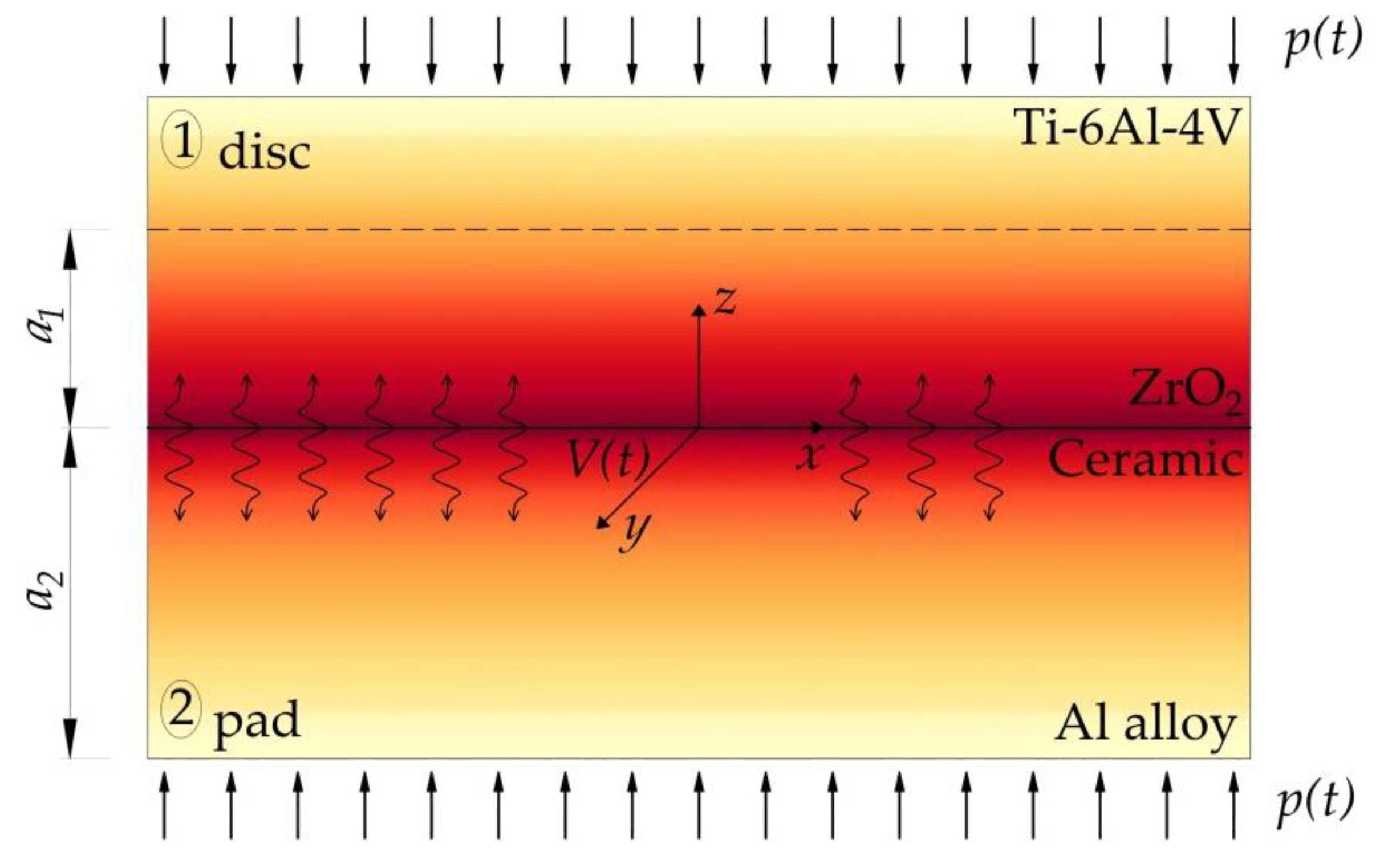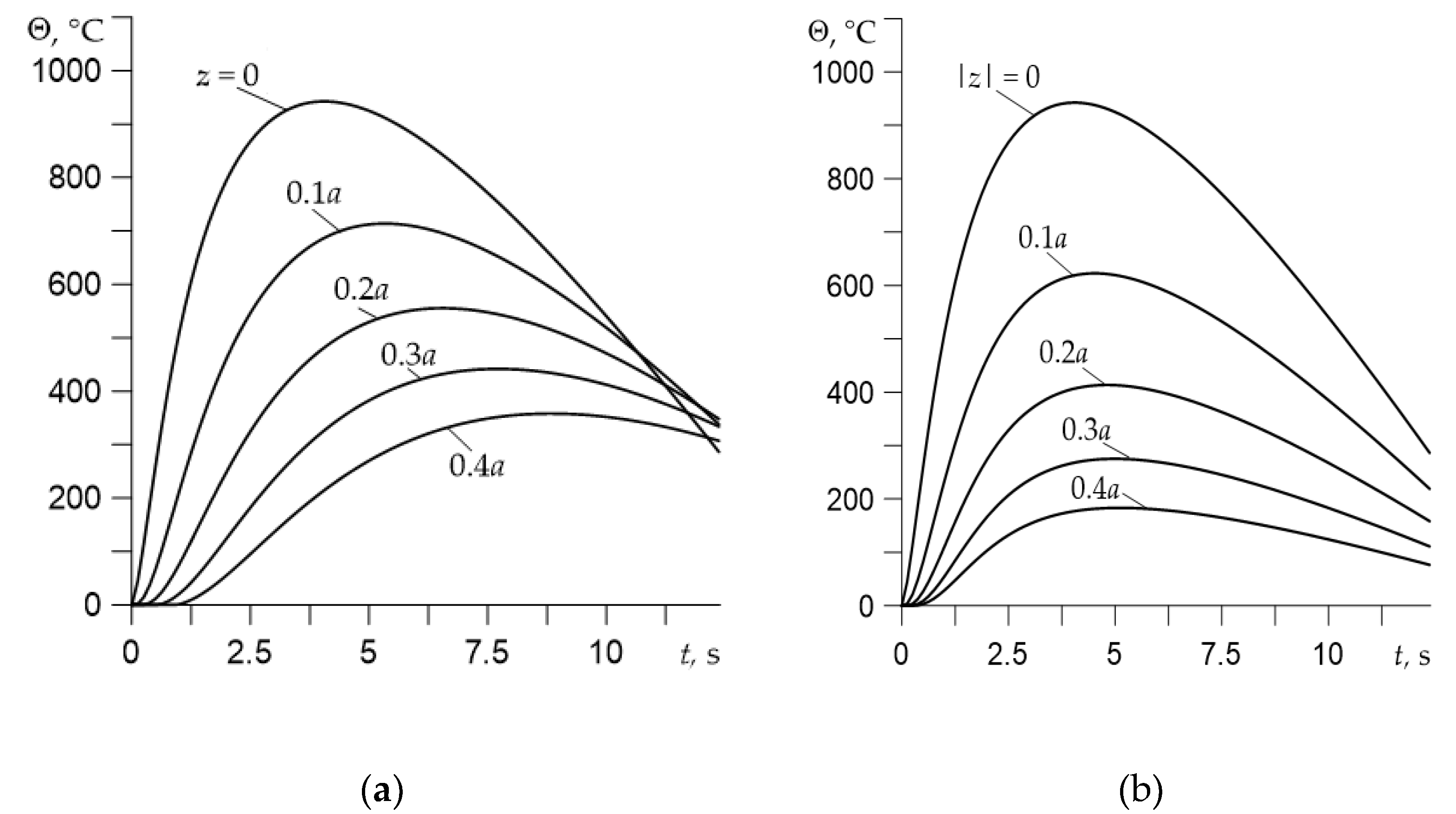The Effect of Functionally Graded Materials on Temperature during Frictional Heating at Single Braking
Abstract
:1. Introduction
2. Statement to the Problem
- The materials of the pads and the disc are functionally graded with an exponential decrease in thermal conductivity along their thickness, with invariant specific heat and density;
- The initial temperature of all elements is the same and equal to the ambient temperature ;
- The whole work of friction goes to heating the bodies, while the wear of the friction surfaces is neglected;
- The free surfaces of the pads and the disc are adiabatic;
- The thermal and mechanical properties and coefficient of friction are independent of the temperature ;
- Only the change in the temperature gradient in the direction perpendicular to the friction surface is taken into account;
- The thermal contact of friction between the pads and the disc is perfect; the temperatures of their friction surfaces during braking are the same, and the sum of the intensity of the heat fluxes directed to both elements along the normal to the contact surface is equal to the specific friction power:where the temporal profiles of pressure and velocity have the forms expressed in Equations (1) and (2), respectively;
- Due to the symmetry with respect to the center plane of the disc, to establish the temperature of the braking system, it is sufficient to consider the contact scheme of one pad with a disc of half of its thickness.
3. Solution to the Problem
4. Dimensionless Form of Solution
5. Numerical Analysis
6. Conclusions
Author Contributions
Funding
Institutional Review Board Statement
Informed Consent Statement
Data Availability Statement
Conflicts of Interest
Nomenclature
| Effective depth of heat penetration () | |
| Area of the nominal contact region () | |
| Specific heat () | |
| Coefficient of friction (dimensionless) | |
| Bessel functions of the first kind of the k-th order | |
| Thermal diffusivity () | |
| Thermal conductivity () | |
| Contact pressure () | |
| Nominal value of the contact pressure () | |
| Specific power of friction () | |
| Nominal value of the specific power of friction () | |
| Time () | |
| Time of the contact pressure increase () | |
| Stop time at braking with constant deceleration () | |
| Stop time () | |
| Temperature () | |
| Initial (ambient) temperature () | |
| Velocity () | |
| Initial velocity () | |
| Initial kinetic energy of the system () | |
| Spatial coordinates () | |
| lower | Number of the main () and frictional () elements of the friction pair |
| Parameter of material gradient () | |
| Parameter of material gradient (dimensionless) | |
| Temperature rise () | |
| Temperature rise (dimensionless) | |
| Temperature scaling factor () | |
| Density () | |
| Time (dimensionless) | |
| Time of contact pressure increase (dimensionless) | |
| Braking time at constant deceleration (dimensionless) | |
| Braking time (dimensionless) | |
| Spatial coordinate in axial direction (dimensionless) |
References
- Govindaraju, M.; Megalingam, A.; Murugasan, J.; Vignesh, R.V.; Kota, P.K.; Ram, A.S.; Lakshana, P.; Kumar, V.N. Investigations on the tribological behavior of functionally gradient iron-based brake pad material. Proc. Inst. Mech. Eng. Part C J. Mech. Eng. Sci. 2020, 234, 2474–2486. [Google Scholar] [CrossRef]
- Swaminathan, K.; Sangeetha, D. Thermal analysis of FGM plates—A critical review of various modeling techniques and solution methods. Compos. Struct. 2017, 160, 43–60. [Google Scholar] [CrossRef]
- Afsar, A.; Go, J. Finite element analysis of thermoelastic field in a rotating FGM circular disk. Appl. Math. Model. 2010, 34, 3309–3320. [Google Scholar] [CrossRef]
- Shahzamanian, M.; Bin Sahari, B.; Bayat, M.; Mustapha, F.; Ismarrubie, Z.N. Finite element analysis of thermoelastic contact problem in functionally graded axisymmetric brake disks. Compos. Struct. 2010, 92, 1591–1602. [Google Scholar] [CrossRef]
- Shahzamanian, M.; Bin Sahari, B.; Bayat, M.; Ismarrubie, Z.N.; Mustapha, F. Transient and thermal contact analysis for the elastic behavior of functionally graded brake disks due to mechanical and thermal loads. Mater. Des. 2010, 31, 4655–4665. [Google Scholar] [CrossRef]
- Hosseini, T.P.; Talebi, M. Stress and temperature distribution study in a functionally graded brake disk. Int. J. Automot. Eng. 2012, 2, 172–179. [Google Scholar]
- Yaghoobi, M.P.; Ghannad, M. An analytical solution for heat conduction of FGM cylinders with varying thickness subjected to non-uniform heat flux using a first-order temperature theory and perturbation technique. Int. Commun. Heat Mass Transf. 2020, 116, 104684. [Google Scholar] [CrossRef]
- Jang, Y.H.; Ahn, S.-H. Frictionally-excited thermoelastic instability in functionally graded material. Wear 2007, 262, 1102–1112. [Google Scholar] [CrossRef]
- Lee, S.W.; Jang, Y.H. Frictionally excited thermoelastic instability in a thin layer of functionally graded material sliding between two half-planes. Wear 2009, 267, 1715–1722. [Google Scholar] [CrossRef]
- Lee, S.W.; Jang, Y.H. Effect of functionally graded material on frictionally excited thermoelastic instability. Wear 2009, 266, 139–146. [Google Scholar] [CrossRef]
- Mao, J.-J.; Ke, L.-L.; Yang, J.; Kitipornchai, S.; Wang, Y.-S. Thermoelastic instability of functionally graded materials with interaction of frictional heat and contact resistance. Mech. Based Des. Struct. Mach. 2017, 46, 139–156. [Google Scholar] [CrossRef]
- Mao, J.-J.; Ke, L.-L.; Yang, J.; Kitipornchai, S.; Wang, Y.-S. The coupled thermoelastic instability of FGM coatings with arbitrarily varying properties: In-plane sliding. Acta Mech. 2018, 229, 2979–2995. [Google Scholar] [CrossRef]
- Kulchytsky-Zhyhailo, R.; Bajkowski, A.S. Axisymmetrical problem of thermoelasticity for halfspace with gradient coating. Int. J. Mech. Sci. 2016, 106, 62–71. [Google Scholar] [CrossRef]
- Martínez-Pañeda, E. On the Finite Element Implementation of Functionally Graded Materials. Materials 2019, 12, 287. [Google Scholar] [CrossRef] [Green Version]
- Mao, J.-J.; Ke, L.-L.; Yang, J.; Kitipornchai, S.; Wang, Y.-S. Thermoelastic instability of functionally graded coating with arbitrarily varying properties considering contact resistance and frictional heat. Appl. Math. Model. 2017, 43, 521–537. [Google Scholar] [CrossRef] [Green Version]
- Polajnar, M.; Kalin, M.; Thorbjornsson, I.; Thorgrimsson, J.; Valle, N.; Botor-Probierz, A. Friction and wear performance of functionally graded ductile iron for brake pads. Wear 2017, 382-383, 85–94. [Google Scholar] [CrossRef]
- Yevtushenko, A.; Topczewska, K.; Zamojski, P. The Effect of Functionally Graded Materials on Temperature during Frictional Heating: Under Uniform Sliding. Materials 2021, 14, 4285. [Google Scholar] [CrossRef] [PubMed]
- Chichinadze, A.V. Polymers in Friction Assembles of Machines and Devices: A Handbook; Allerton Press Inc: New York, NY, USA, 1984. [Google Scholar]
- Topczewska, K. Influence of the Time of Increase in Contact Pressure in the Course of Braking on the Temperature of a Pad–Disc Tribosystem. Mater. Sci. 2018, 54, 250–259. [Google Scholar] [CrossRef]
- Yevtushenko, A.; Kuciej, M.; Topczewska, K. Some theoretical model for determining the temperature field of a multi-disk brake. Adv. Mech. Eng. 2020, 12. [Google Scholar] [CrossRef]
- Abramowitz, M.; Stegun, I. Handbook of Mathematical Functions with Formulas, Graphs, and Mathematical Tables; United States Department of Commerce, National Bureau of Standards (NBS): Washington, WA, USA, 1964. [Google Scholar]
- Özis̨ik, N.M. Heat conduction; John Wiley: New York, NY, USA, 1993. [Google Scholar]
- Chichinadze, A.V.; Braun, E.D.; Ginzburg, A.G.; Ignat’eva, E.V. Calculation, Testing and Selection of Friction Couples; Nauka: Moscow, Russia, 1979. (In Russian) [Google Scholar]
- Yevtushenko, A.; Kuciej, M. Frictional heating during braking in a three-element tribosystem. Int. J. Heat Mass Transf. 2009, 52, 2942–2948. [Google Scholar] [CrossRef]
- Tian, J.; Jiang, K. Heat conduction investigation of the functionally graded materials plates with variable gradient parameters under exponential heat source load. Int. J. Heat Mass Transf. 2018, 122, 22–30. [Google Scholar] [CrossRef]
- Chichinadze, A.V.; Kozhemyakina, V.D.; Suvorov, A.V. Method of temperature-field calculation in model ring specimens during bilateral friction in multidisc aircraft brakes with the IM-58-T2 new multipurpose friction machine. J. Frict. Wear 2010, 31, 23–32. [Google Scholar] [CrossRef]
- Evtushenko, O.; Kuciej, M.; Topczewska, K. Determination of the Maximal Temperature of a Pad–Disk Tribosystem during One-Time Braking. Mater. Sci. 2020, 56, 152–159. [Google Scholar] [CrossRef]
- Yevtushenko, A.; Topczewska, K.; Kuciej, M. Analytical Determination of the Brake Temperature Mode during Repetitive Short-Term Braking. Materials 2021, 14, 1912. [Google Scholar] [CrossRef] [PubMed]






Publisher’s Note: MDPI stays neutral with regard to jurisdictional claims in published maps and institutional affiliations. |
© 2021 by the authors. Licensee MDPI, Basel, Switzerland. This article is an open access article distributed under the terms and conditions of the Creative Commons Attribution (CC BY) license (https://creativecommons.org/licenses/by/4.0/).
Share and Cite
Yevtushenko, A.; Topczewska, K.; Zamojski, P. The Effect of Functionally Graded Materials on Temperature during Frictional Heating at Single Braking. Materials 2021, 14, 6241. https://doi.org/10.3390/ma14216241
Yevtushenko A, Topczewska K, Zamojski P. The Effect of Functionally Graded Materials on Temperature during Frictional Heating at Single Braking. Materials. 2021; 14(21):6241. https://doi.org/10.3390/ma14216241
Chicago/Turabian StyleYevtushenko, Aleksander, Katarzyna Topczewska, and Przemysław Zamojski. 2021. "The Effect of Functionally Graded Materials on Temperature during Frictional Heating at Single Braking" Materials 14, no. 21: 6241. https://doi.org/10.3390/ma14216241
APA StyleYevtushenko, A., Topczewska, K., & Zamojski, P. (2021). The Effect of Functionally Graded Materials on Temperature during Frictional Heating at Single Braking. Materials, 14(21), 6241. https://doi.org/10.3390/ma14216241








